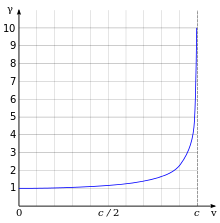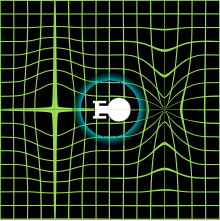Warp drive

| Spatial anomalies in fiction |
|---|
|
Black holes in fiction • Portable hole • Teleportation in fiction • Wormholes in fiction • Stargate • Warp drive • Hyperspace • Time travel in fiction |
|
Science fiction portal |
A warp drive or a drive enabling space warp is a fictional superluminal (faster than the speed of light) spacecraft propulsion system in many science fiction works, most notably Star Trek,[1] and a subject of ongoing physics research. The general concept of "warp drive" was introduced by John W. Campbell in his 1957 novel Islands of Space and was popularized by the Star Trek series. Its closest real-life equivalent is the Alcubierre drive, a theoretical solution of the field equations of general relativity.[2]
History and characteristics
Warp drive, or a drive enabling space warp, is one of
The general concept of warp drive was introduced by
Einstein's space warp and real-world physics

Einstein's theory of special relativity states that speed of light travel is impossible for material objects that, unlike photons, have a non-zero rest mass. The problem of a material object exceeding light speed is that an infinite amount of kinetic energy would be required to travel at exactly the speed of light. Warp drives are one of the science-fiction tropes that serve to circumvent this limitation in fiction to facilitate stories set at galactic scales.[11] However, the concept of space warp has been criticized as "illogical", and has been connected to several other rubber science ideas that do not fit into our current understanding of physics, such as antigravity or negative mass.[3]
Some argue that these effects mean that although it's not possible to travel faster than the speed of light, both space and time "warp" to allow travelling the distance of one light year, in less than a year. Although it is not possible to travel faster than the speed of light, the effective speed is faster than light. This warping of space and time is precisely mathematically specified by the Lorentz factor, which depends on velocity. Although only theoretical when published over 100 years ago, the effect has since been measured and confirmed many times. In the limit, at light speed time stops completely and it is possible to travel infinite distances across space with no passage of time.[12][13][14][15]
Although the concept of warp drive has originated in fiction, it has received some scientific consideration, most notably related to the 1990s concept of the Alcubierre drive.[8] Alcubierre stated in an email to William Shatner that his theory was directly inspired by the term used in the TV series Star Trek[16] and cites the "'warp drive' of science fiction" in his 1994 article.[2]
In 2021, DARPA-funded researcher Harold White, of the Limitless Space Institute, claimed that he had succeeded in creating a real warp bubble, saying "our detailed numerical analysis of our custom Casimir cavities helped us identify a real and manufacturable nano/microstructure that is predicted to generate a negative vacuum energy density such that it would manifest a real nanoscale warp bubble, not an analog, but the real thing."[17]
Star Trek

Warp drive is one of the fundamental features of the Star Trek franchise and one of the best-known examples of space warp (warp drive) in fiction.
The basic functional principle of the warp drive in Star Trek is the same for all spaceships. A strong energy source, usually a so-called warp core or sometimes called intermix chamber, generates a high-energy plasma. This plasma is transported to the so-called warp field generators via lines that are reminiscent of pipes. These generators are basically coils in warp nacelles protruding from the spaceship. These generate a subspace field, the so-called warp field or a warp bubble, which distort space-time and propels the bubble and spaceship in the bubble forward.[19]
The warp core can be designed in various forms. Humans and most of the other fictional races use a moderated reaction of
The speeds are given in warp factors and follow a
In the episode "
Star Trek has also introduced a so-called Transwarp concept, but without a fixed definition.[24] It is effectively a catch-all phrase for any and all technologies and natural phenomena that enable speeds above Warp 9.99.[26]
Rick Sternbach described the basic idea in the Technical Manual:
"Finally, we had to provide some loophole for various powerful aliens like Q, who have a knack for tossing the ship million of light years in the time of a commercial break. [...] This lets Q and his friends have fun in the 9.9999+ range, but also lets our ship travel slowly enough to keep the galaxy a big place, and meets the other criteria."[22]
See also
- Bussard collector
- Exotic matter
- Gravitational interaction of antimatter
- Krasnikov tube
- Negative energy
- Tachyons
- Timeline of black hole physics
- Timeline of gravitational physics and relativity
References
- OCLC 787849957.
- ^ S2CID 4797900.
- ^ a b c d "SFE: Space Warp". sf-encyclopedia.com. Retrieved 2021-11-10.
- ISBN 978-0-415-97460-8.
- ^ ISBN 978-0-19-988552-7.
- ISBN 978-1-60805-270-7.
- ^ a b Miozzi, CJ (18 June 2014). "5 Faster-Than-Light Travel Methods and Their Plausibility". The Escapist. Retrieved 11 November 2021.
- ^ Bibcode:2008JBIS...61..353G.
- ISBN 978-0-517-53174-7.
- ^ "Themes : Space Warp : SFE : Science Fiction Encyclopedia". www.sf-encyclopedia.com. Retrieved 2021-09-04.
- ^ "SFE: Faster Than Light". sf-encyclopedia.com. Retrieved 2021-11-10.
- .
- ^ Minkowski, Hermann (1908) [1907], [The Fundamental Equations for Electromagnetic Processes in Moving Bodies], Nachrichten von der Gesellschaft der Wissenschaften zu Göttingen, Mathematisch-Physikalische Klasse, pp. 53–111
- ^ Overbye, Dennis (2005-06-28). "A Trip Forward in Time. Your Travel Agent: Einstein". The New York Times. Retrieved 2015-12-08.
- ^ Gott, Richard J. (2002). Time Travel in Einstein's Universe. p. 75.
- ^ Shapiro, Alan. "The Physics of Warp Drive". Archived from the original on 24 April 2013. Retrieved 2 June 2013.
- ^ Coontz, Lauren (December 9, 2021). "DARPA and NASA Scientists Accidentally Create Warp Bubble for Interstellar Travel". Coffee or Die Magazine. Retrieved 2024-05-27.
- ^ Dodds, Alice Rose (2022-06-10). "Star Trek's Warp Drive Technology, Explained". Game Rant. Retrieved 2023-01-19.
- ^ Okuda, Michael & Denise. Star Trek Technical Manual. p. 56.
- ^ Star Trek Fact Files, File 64, Card 6, Warp core function
- ^ Joseph, Franz. Star Trek: Star Fleet Technical Manual.
- ^ a b c d Okuda, Michael & Denise. Star Trek Technical Manual. p. 55.
- ^ "The Voyager Transcripts - The 37's". www.chakoteya.net. Retrieved 2024-05-27.
- ^ a b Okuda, Michael & Denise. Star Trek Encyclopedia. p. 413.
- ^ Okuda, Michael & Denise. Star Trek Encyclopedia. p. 149.
- ^ "Star Trek Fact Files". p. File 5, Card 19.
{{cite magazine}}: Cite magazine requires|magazine=(help)
External links
- Embedding of the Alcubierre Warp drive 2d plot in Google
- Warp drive at Memory Alpha
- Warp core at Memory Alpha
- Transwarp drive at Memory Alpha
- Quantum slipstream drive at Memory Alpha
- Warp Drive, When? A NASA feasibility article
- Special Relativity Simulator What would things look like at near-warp speeds?
- Alcubierre Warp Drive at the Encyclopedia of Astrobiology, Astronomy, and Spaceflight
- "Warp drive possible". BBC News. 1999-06-10. Retrieved 2008-08-05.
- The Warp Drive Could Become Science Fact Archived 2012-11-23 at the Wayback Machine

